Wei-Ta Chu
Transformer-based Clipped Contrastive Quantization Learning for Unsupervised Image Retrieval
Jan 27, 2024Abstract:Unsupervised image retrieval aims to learn the important visual characteristics without any given level to retrieve the similar images for a given query image. The Convolutional Neural Network (CNN)-based approaches have been extensively exploited with self-supervised contrastive learning for image hashing. However, the existing approaches suffer due to lack of effective utilization of global features by CNNs and biased-ness created by false negative pairs in the contrastive learning. In this paper, we propose a TransClippedCLR model by encoding the global context of an image using Transformer having local context through patch based processing, by generating the hash codes through product quantization and by avoiding the potential false negative pairs through clipped contrastive learning. The proposed model is tested with superior performance for unsupervised image retrieval on benchmark datasets, including CIFAR10, NUS-Wide and Flickr25K, as compared to the recent state-of-the-art deep models. The results using the proposed clipped contrastive learning are greatly improved on all datasets as compared to same backbone network with vanilla contrastive learning.
Vision Transformer Hashing for Image Retrieval
Sep 26, 2021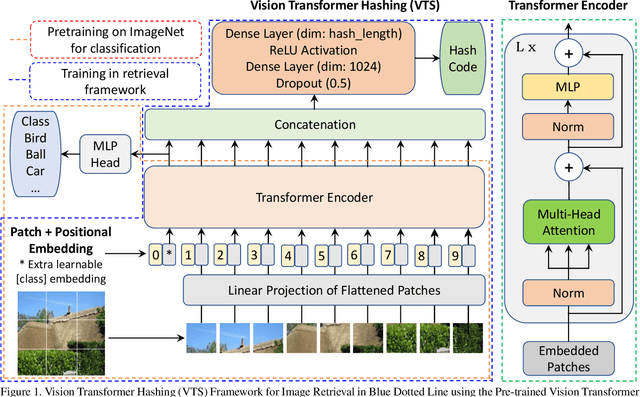
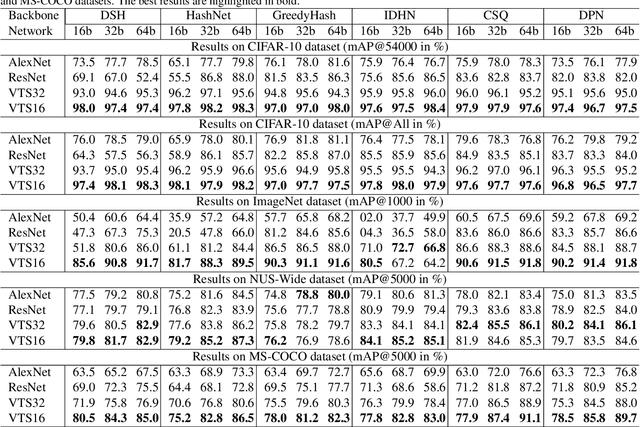
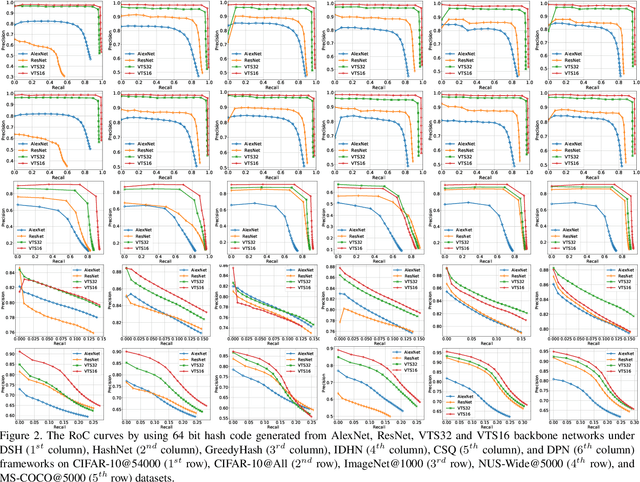

Abstract:Deep learning has shown a tremendous growth in hashing techniques for image retrieval. Recently, Transformer has emerged as a new architecture by utilizing self-attention without convolution. Transformer is also extended to Vision Transformer (ViT) for the visual recognition with a promising performance on ImageNet. In this paper, we propose a Vision Transformer based Hashing (VTS) for image retrieval. We utilize the pre-trained ViT on ImageNet as the backbone network and add the hashing head. The proposed VTS model is fine tuned for hashing under six different image retrieval frameworks, including Deep Supervised Hashing (DSH), HashNet, GreedyHash, Improved Deep Hashing Network (IDHN), Deep Polarized Network (DPN) and Central Similarity Quantization (CSQ) with their objective functions. We perform the extensive experiments on CIFAR10, ImageNet, NUS-Wide, and COCO datasets. The proposed VTS based image retrieval outperforms the recent state-of-the-art hashing techniques with a great margin. We also find the proposed VTS model as the backbone network is better than the existing networks, such as AlexNet and ResNet.
Frequency Disentangled Residual Network
Sep 26, 2021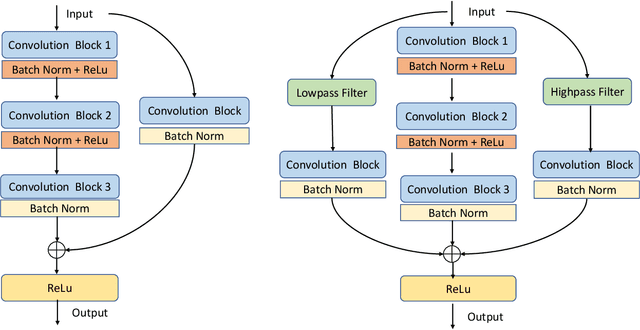
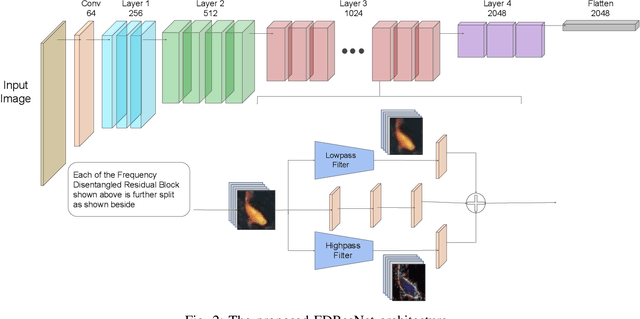


Abstract:Residual networks (ResNets) have been utilized for various computer vision and image processing applications. The residual connection improves the training of the network with better gradient flow. A residual block consists of few convolutional layers having trainable parameters, which leads to overfitting. Moreover, the present residual networks are not able to utilize the high and low frequency information suitably, which also challenges the generalization capability of the network. In this paper, a frequency disentangled residual network (FDResNet) is proposed to tackle these issues. Specifically, FDResNet includes separate connections in the residual block for low and high frequency components, respectively. Basically, the proposed model disentangles the low and high frequency components to increase the generalization ability. Moreover, the computation of low and high frequency components using fixed filters further avoids the overfitting. The proposed model is tested on benchmark CIFAR10/100, Caltech and TinyImageNet datasets for image classification. The performance of the proposed model is also tested in image retrieval framework. It is noticed that the proposed model outperforms its counterpart residual model. The effect of kernel size and standard deviation is also evaluated. The impact of the frequency disentangling is also analyzed using saliency map.
Searching by Generating: Flexible and Efficient One-Shot NAS with Architecture Generator
Mar 12, 2021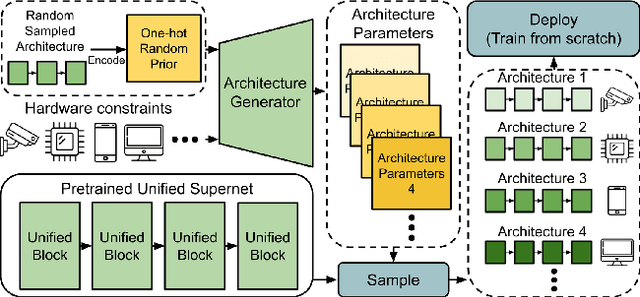


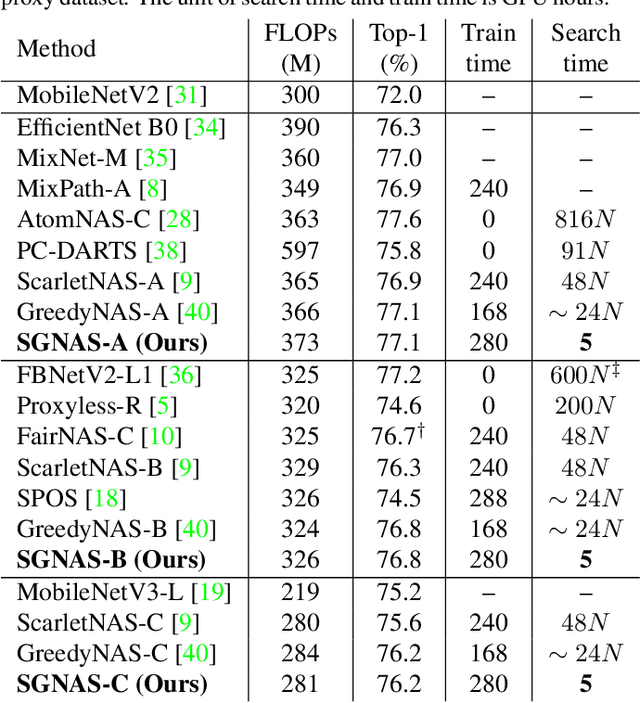
Abstract:In one-shot NAS, sub-networks need to be searched from the supernet to meet different hardware constraints. However, the search cost is high and $N$ times of searches are needed for $N$ different constraints. In this work, we propose a novel search strategy called architecture generator to search sub-networks by generating them, so that the search process can be much more efficient and flexible. With the trained architecture generator, given target hardware constraints as the input, $N$ good architectures can be generated for $N$ constraints by just one forward pass without re-searching and supernet retraining. Moreover, we propose a novel single-path supernet, called unified supernet, to further improve search efficiency and reduce GPU memory consumption of the architecture generator. With the architecture generator and the unified supernet, we propose a flexible and efficient one-shot NAS framework, called Searching by Generating NAS (SGNAS). With the pre-trained supernt, the search time of SGNAS for $N$ different hardware constraints is only 5 GPU hours, which is $4N$ times faster than previous SOTA single-path methods. After training from scratch, the top1-accuracy of SGNAS on ImageNet is 77.1%, which is comparable with the SOTAs. The code is available at: https://github.com/eric8607242/SGNAS.
PONAS: Progressive One-shot Neural Architecture Search for Very Efficient Deployment
Apr 09, 2020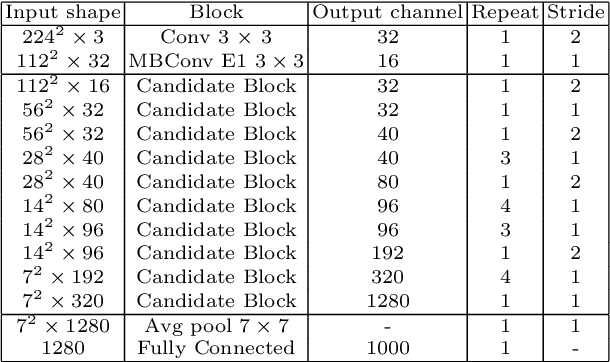
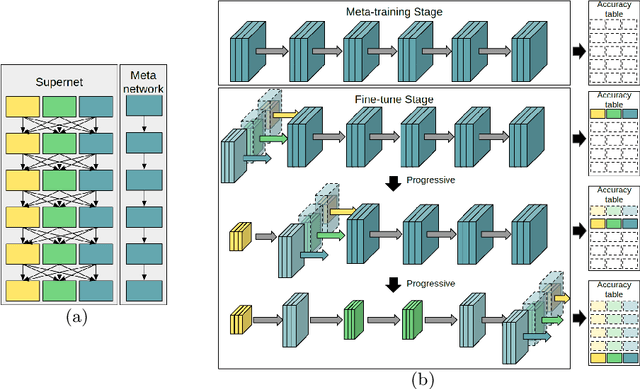
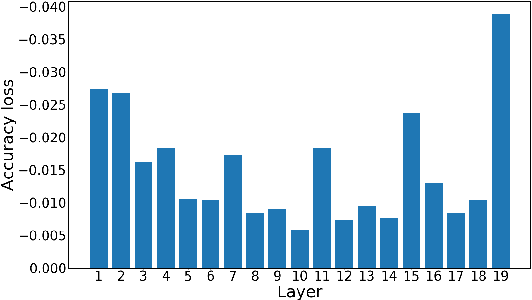
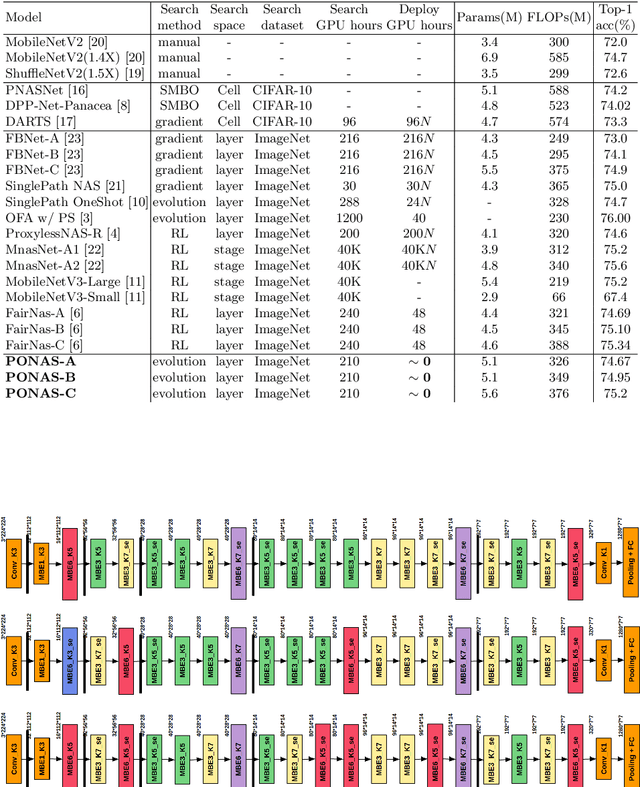
Abstract:We achieve very efficient deep learning model deployment that designs neural network architectures to fit different hardware constraints. Given a constraint, most neural architecture search (NAS) methods either sample a set of sub-networks according to a pre-trained accuracy predictor, or adopt the evolutionary algorithm to evolve specialized networks from the supernet. Both approaches are time consuming. Here our key idea for very efficient deployment is, when searching the architecture space, constructing a table that stores the validation accuracy of all candidate blocks at all layers. For a stricter hardware constraint, the architecture of a specialized network can be very efficiently determined based on this table by picking the best candidate blocks that yield the least accuracy loss. To accomplish this idea, we propose Progressive One-shot Neural Architecture Search (PONAS) that combines advantages of progressive NAS and one-shot methods. In PONAS, we propose a two-stage training scheme, including the meta training stage and the fine-tuning stage, to make the search process efficient and stable. During search, we evaluate candidate blocks in different layers and construct the accuracy table that is to be used in deployment. Comprehensive experiments verify that PONAS is extremely flexible, and is able to find architecture of a specialized network in around 10 seconds. In ImageNet classification, 75.2% top-1 accuracy can be obtained, which is comparable with the state of the arts.
Visual Weather Temperature Prediction
Jan 25, 2018
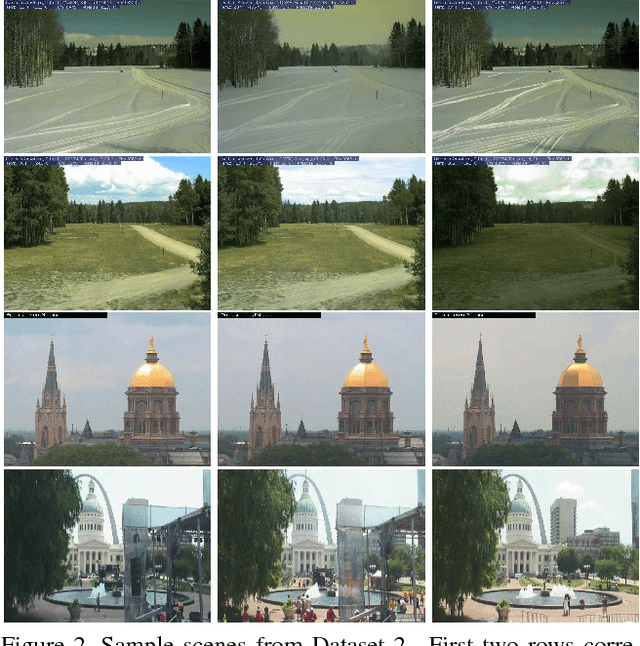


Abstract:In this paper, we attempt to employ convolutional recurrent neural networks for weather temperature estimation using only image data. We study ambient temperature estimation based on deep neural networks in two scenarios a) estimating temperature of a single outdoor image, and b) predicting temperature of the last image in an image sequence. In the first scenario, visual features are extracted by a convolutional neural network trained on a large-scale image dataset. We demonstrate that promising performance can be obtained, and analyze how volume of training data influences performance. In the second scenario, we consider the temporal evolution of visual appearance, and construct a recurrent neural network to predict the temperature of the last image in a given image sequence. We obtain better prediction accuracy compared to the state-of-the-art models. Further, we investigate how performance varies when information is extracted from different scene regions, and when images are captured in different daytime hours. Our approach further reinforces the idea of using only visual information for cost efficient weather prediction in the future.
 Add to Chrome
Add to Chrome Add to Firefox
Add to Firefox Add to Edge
Add to Edge